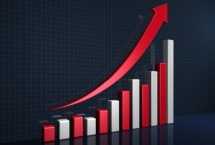The forecast rate of growth for 2011 is 5.2%. The rate of unemployment is expected to decline to an average of 5.8%
The Bank of Israel is raised last week its growth forecast for the Israeli economy, following a 4.7% growth in the first quarter of 2011.
The forecast rate of growth for 2011 is 5.2%. The rate of unemployment is expected to decline to an average of 5.8%. The rapid growth of GDP and use of resources in the first quarter, and in particular the surge in exports and fixed investment, resulted in an upward revision of most items.
Despite the rapid increase in exports, the surplus in the current account of the balance of payments is expected to be significantly smaller than in the previous forecast, because of a faster increase in imports and a more severe deterioration in the terms of trade. The quarterly rates of growth are expected to slow a little in the course of the year as the economy converges to a full employment situation.
In March, the Bank of Israel predicted that Israeli economy would grow by only 4.5% in 2011, and by 4% in 2012. In the same annual report, the bank's economists said the average unemployment rate in 2011 would total 6.1%.
For 2012 GDP is expected to grow by 4.2%, with the unemployment rate stabilizing at 5.8%. Exports are expected to continue increasing, at a rate slightly below that of world trade, due to both external forces––the deterioration in the terms of trade––and the level of the real exchange rate.
The steep increase in capital stock, the result of the expansion of investment in 2011, and the continued rise in the rate of participation in the labor force, to 58%, are expected to contribute to a growth rate in 2012 in excess of the potential rate, despite the fact that the economy is in a full employment environment.
Bank of Israel updated macroeconomic forecast for 2011 and 2012
The forecast rate of growth for 2011 is 5.2%. The rate of unemployment is expected to decline to an average of 5.8%
05.06.11 / 00:00
•
More articles that may interest you

Israel company sanctioned by US for ties to Iran

Israel Ranked 17th in IMD World Competitiveness Yearbook 2011

OECD: growth forecast for Israel 5.4% in 2011

BoI: Composite State-of-the-Economy index for April 2011 increased by 0.2%

El Al Airlines: Q1 loss widens to $42.9 million

Government increases state guarantees for exporters
More news from Industry & Trade Section
>CBS: Israel April CPI +0.6%/22.05.11
>CBS: trade deficit totaled $1.0 billion in April 2011/22.05.11
>IEICI: Israel's exports have grown 13,400 times since the State's establishment/22.05.11
>CBS: Israeli economy grew 4.7% in Q1/22.05.11
>Bank of Israel: foreign currency reserves rise to record US$77.4b/16.05.11
>63rd Independence Day: 7,746,000 residents in the State of Israel/16.05.11
>CBS: trade deficit in April 2011 totaled US$1.8 billion/16.05.11
>ICC to assist the development of an arbitration centre in Jerusalem/08.05.11
>April 2011- Consumer Confidence Index up 4.2 points/08.05.11
>Fischer leaves key interest rate unchanged/02.05.11
